Power, progress and a pandemic: Steve Sisolak’s legacy as Nevada governor
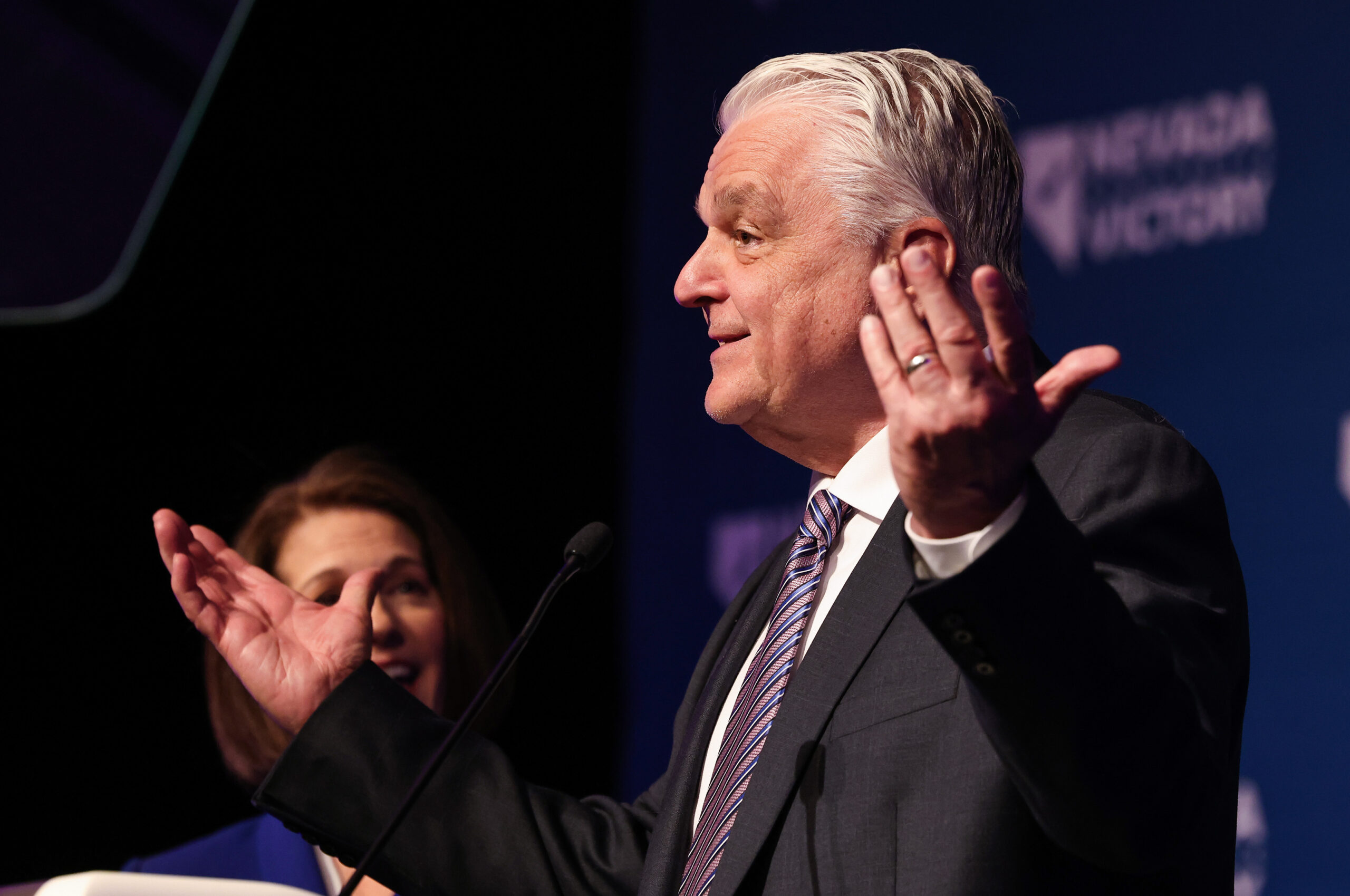
When Steve Sisolak won the governor’s race in 2018, it marked the first time Nevada elected a Democratic governor in two decades, ushered in by a blue wave that also gave Democrats their first trifecta — control of the governor’s mansion, the Senate and the Assembly — in three decades.
This week, he is ceding the governor’s mansion to his Republican opponent, Joe Lombardo, after becoming the only incumbent Democratic governor nationwide to lose in 2022. The trifecta has come to an end, and with it, the carte blanche Democratic legislative power defined in large part by the limits of that power.
Sisolak, 69, had for years served as a Democratic fixture in Las Vegas. A native of Milwaukee, Wisconsin, the would-be governor came to Southern Nevada for a graduate degree in the late 1970s before setting up a telemarketing business — though it would be another two decades before he touched public office.
For 10 years, Sisolak served on the periphery of the state’s electoral universe as a member of the Board of Regents, the governing body of Nevada’s colleges and universities. He moved closer to the center of gravity in 2008, elected to the Clark County Commission — by far the state’s most powerful county board, with control over the Las Vegas Strip — in another post he would hold for a decade.
In the four years after campaigning as a centrist and defeating a more liberal primary opponent, Sisolak wielded the governor’s power to enact sweeping Democratic policy goals — but often in ways that fell short of what Democrat-aligned activists had jockeyed for. Amid a push for a $15 minimum wage, Sisolak upped the state’s minimum wage to just $12 over five years. In the midst of otherwise expansive criminal justice reforms that reduced certain criminal penalties, Sisolak also directly intervened to preserve the death penalty.
Then came COVID.
Sisolak was among a host of Democratic governors nationwide that acted to shut down “non-essential” businesses as a means to limit spread of the virus in the earliest days of the pandemic. In Nevada, that meant the unprecedented step of closing the Las Vegas Strip, leaving Las Vegas Boulevard barren and casino doors chained shut.
Unemployment in Nevada spiked to historic levels in the short term, rising to nearly 29 percent. A logistical crisis then followed, as massive federal aid packages for the unemployed barrelled into an antiquated and undermanned system that buckled under the unprecedented levels of need.
Even late in his term, Sisolak’s tenure was defined by his COVID response — a response he argued saved lives, even if it caused collateral economic damage.
For months, as new variants ebbed and flowed, Sisolak’s mandates for masks and the backing of some vaccine mandates for state employees sparked fierce backlash, including protests that followed the governor to his Las Vegas home.
“The unfortunate thing with a pandemic is the decisions you have to make in an emergency like that are sometimes going to be very unpopular,” said epidemiologist Brian Labus.
As the 2022 midterms arrived, those pandemic decisions cast a long shadow over the campaign. Last month, voters rejected Sisolak by a 1.5 percentage point margin. It came as housing prices had soared, inflation had squeezed the economy, and the future remained uncertain.
In the lame duck period that followed, the outgoing governor made final Hail Mary policy plays.
After punting on a push by some Democratic lawmakers to end the death penalty during the last legislative session, Sisolak briefly sought to commute Nevada’s death row inmates to life in prison without parole — a move that was quickly dashed on account of insufficient notice to crime victims.
He also sought to leave his mark on a state budget he will no longer control. Last week, he called for a 10 percent raise for state workers in the next fiscal year, with another 5 percent raise the year after that, as well as more than doubling state education funding from $3 billion per biennium to $8.2 billion.
On Tuesday, Sisolak — largely silent after his electoral loss, and having declined an interview with The Nevada Independent — issued a final farewell statement with the governor’s letterhead, describing the last four years as “a time of great struggle and a period of great progress.”
“The path we chartered for our State will continue on for decades to come,” he said.
On solving the education quagmire
Education advocates and leaders have mixed feelings about what Sisolak was able to do for Nevada’s K-12 schools during his time as governor, and what he could have done better.
When he ran for the office in 2018, Sisolak positioned himself as an education champion. To prove his resolve, he promised to donate his salary every quarter to the more than 400 Title I schools in Nevada that serve a high percentage of students from low-income families.
One of his early accomplishments on education was a 3 percent raise for Nevada teachers in his 2019 budget, which lawmakers approved during that year’s legislative session.
While two of the state’s largest teacher unions, the Nevada State Education Association and the Clark County Education Association, applaud the raise, which was a first in over a decade, they said it wasn’t enough amid a spike in the consumer price index of more than 7 percent in just the last 12 months.
“At the time, we were also advocating that beyond the one-time adjustment, you would need an ongoing adjustment just to even keep up with inflation,” said CCEA Executive Director John Vellardita.
During Sisolak’s term, Nevada overhauled its decades-old school funding formula and converted over the new Pupil Centered Funding Plan, and passed a major mining tax package that allocated a combined $500 million to public education through new and extended mining taxes and federal COVID relief dollars, and is projected to bring in between $150 million annually.
Sisolak’s relationship with CCEA remained rocky through the end of his tenure, however, and the union declined to endorse his re-election bid in 2022. Speaking to The Nevada Independent, Vellardita also downplayed Sisolak’s involvement in the mining deal as the head of the state’s Democrats, arguing that it was a legislative accomplishment and Sisolak’s role was that “he signed them.”
Sisolak was also unable to meet a pair of the loftiest — and to many, most important — education goals he set when he ran for office: To restore school funding to pre-recession levels and reduce class sizes.
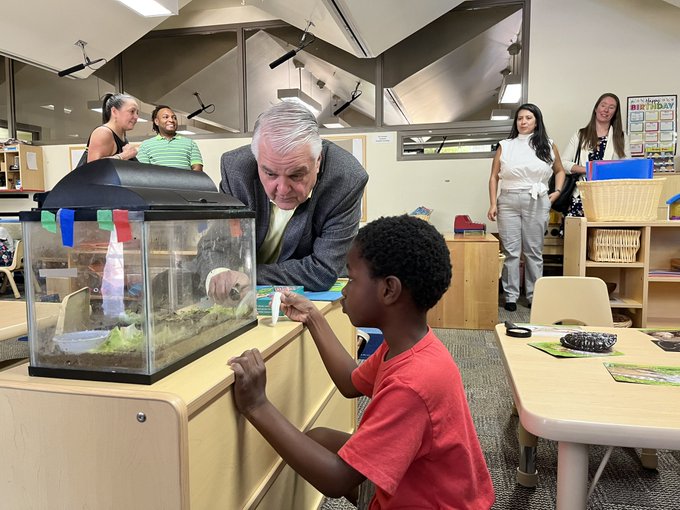
An analysis from the Education Law Center found that when adjusted for inflation, education funding in Nevada fell from $12,122 per pupil in 2008 to $11,076 — a 9 percent decrease. That funding level puts Nevada in the bottom 10 states.
That number comes despite a report from the state’s Commission on School Funding, established in 2019 under Sisolak and the Democrat-led Legislature, which recommended that school funding should reach $14,337 per pupil (in 2020 dollars, adjusting for inflation) — a 55 percent increase from the state’s then-current funding commitment, and a change the commission recommended funding through the use of expanded property and sales taxes.
A recent report by the Nevada Department of Education found that from April to June, 13 school districts exceeded the target class size ratio for one or more grades. The Clark County School District reported having, in one extreme example, a third grade class of 69 students at an online school — well over the recommended ratio of 18 students to a teacher for that grade level.
And over time, Sisolak has faced more criticism for his decision to order the closure of physical spaces for schools for the final months of the 2019-2020 school year — now one of the most controversial COVID mitigation orders amid mounting evidence that pandemic-related learning loss was deeper in states with longer in-person school closures and that such approaches deepened existing inequities for underserved student populations.
After the first few months, Sisolak left it up to each school district to decide how they would handle classes the following school year, provided that they create safety plans, though he did mandate face mask policies for staff and students.
Still, at least some education groups — notably the Nevada State Education Association (NSEA), the state teachers union — back the governor’s decisions on schools and the pandemic.
“I commend Gov. Sisolak for always keeping education in his sights during COVID,” said NSEA President Dawn Etcheverry. “He governed during a very hard time – we all came out of it with some bumps and bruises – but he held his head up. He wanted to make sure children and educators were safe and for that, I will always be grateful to him.”
Higher education
Sisolak also sought to lay the groundwork for major revisions to the structure of the Nevada System of Higher Education (NSHE) in the name of improving workforce development, though his tenure stopped short of any serious reforms to how the system is structured.
Economic diversification — long a marquee goal of Sisolak’s predecessor, Republican Gov. Brian Sandoval — still loomed as a vexing political challenge. If Nevada was to move away from the Las Vegas Strip as its fiscal engine and build a more resilient economy, how would it do so?
For Sisolak, part of the answer is the state’s four community colleges.
Staffed by education, business and labor experts, the so-called AB450 Committee has been tasked with reevaluating not only the “alignment” between the workforce programs at those colleges and the state’s workforce goals, but also sweeping questions about how those colleges are governed by NSHE and the Board of Regents, and whether the state’s now 10-year-old funding formula needs yet another overhaul.
The committee’s work led to an exploratory $5 million program Sisolak has branded as “free community college,” which expanded existing Nevada Promise Scholarships that paid off tuition and fees for about 1,400 of the state’s 48,000 community college students.
The creation of that committee came at a crossroads for higher education in Nevada at which Southern Nevada business groups are pushing to overhaul NSHE and reduce the power of the elected Board of Regents, including through a failed ballot question.
Sisolak has since 2019 touted his direct involvement in negotiations with those same business groups in the construction of the UNLV Medical School’s $125 million educational building — a process that ultimately bypassed NSHE and the university, and was financed by a private corporation buoyed by $25 million in state dollars.
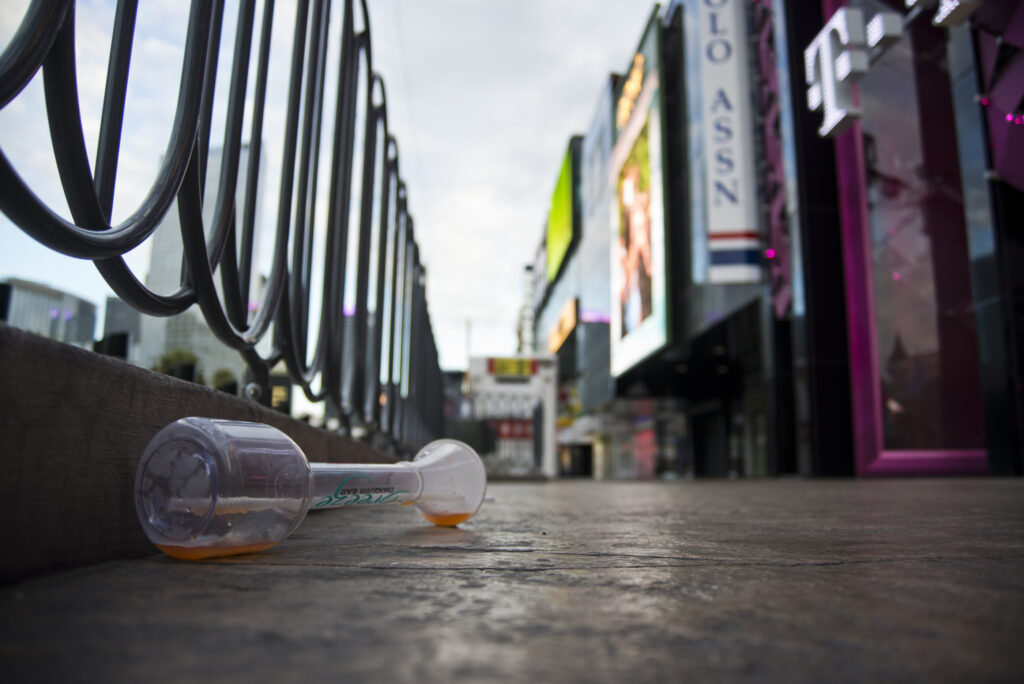
The COVID emergency
No single issue defined the governor’s tenure like the pandemic.
The first weeks of the COVID pandemic were characterized by uncertainty, as all levels of government struggled to respond to a disease that presented more questions than answers and worst-case scenarios played out in places such as New York City. On March 12, 2020, Sisolak had ordered a state of emergency in a press conference where he also urged Nevadans to take personal steps like coughing into their sleeves, rather than into the air.
By March 17, Sisolak ordered all non-essential businesses to close, something he described at the time as “our only chance at flattening the curve.”
What followed was the unprecedented shuttering of the Las Vegas Strip, a move that upended the state’s largest and most durable economic engine overnight, replacing a stream of bumper-to-bumper traffic on Las Vegas Boulevard with dust and tumbleweeds.
Multiple hospitality executives declined to comment to The Nevada Independent about Sisolak’s tenure.
But Labus, an infectious disease epidemiologist and assistant professor at UNLV who worked on Sisolak’s five-member COVID advisory task force, told The Nevada Independent that all governors at the time faced such challenges.
“No matter who the governor was, they were going to have to make decisions that affected people's livelihood, with the idea that we were trying to save lives,” Labus said. “It's not like he wanted to shut down the economy or anything like that. It's not like he wanted to put any of these restrictions in place.”
Labus also praised the governor for listening to public health officials, and said there was no way to know how many lives were theoretically saved by closures, mask mandates or other measures.
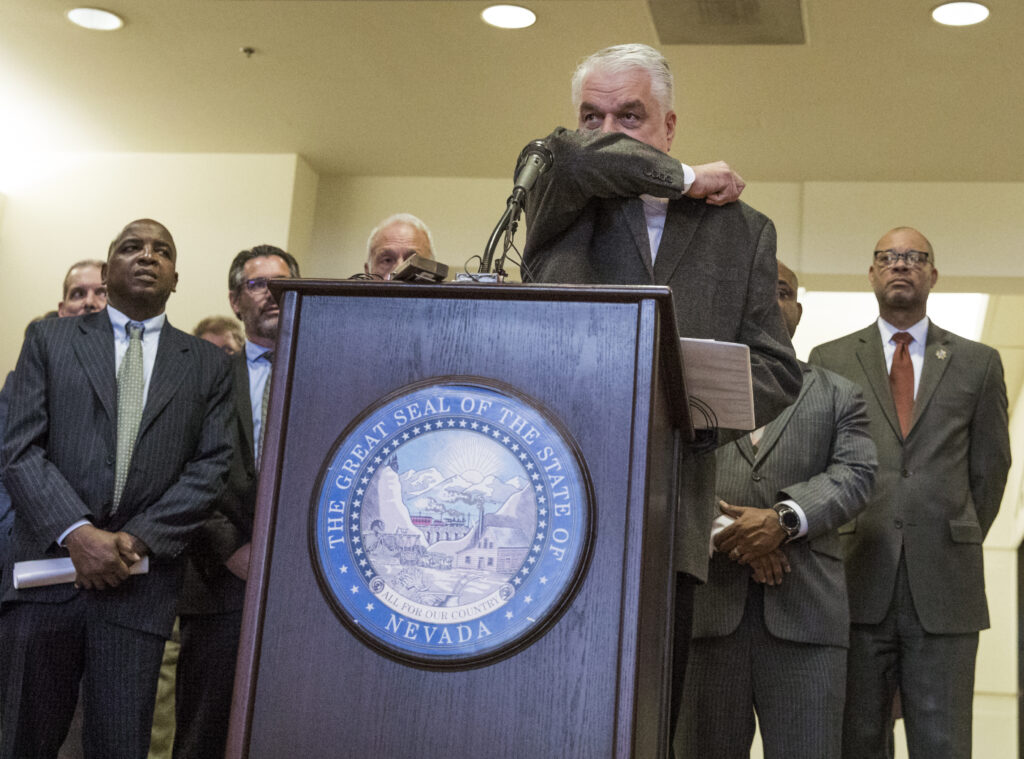
“We can't explain what didn't happen because we took action,” Labus said. “It's very difficult to do that with COVID, especially with every single decision because it wasn't like we were doing just one thing. We were doing hundreds of different things.”
Similarly, Christopher Lake of the Nevada Hospital Association said Sisolak “found himself in an untenable position,” likening addressing the crisis to riding a unicycle while juggling as he sought to satisfy the public health experts and the state’s business sectors.
“And just like when you're juggling, you can never have any two balls at the peak,” Lake said. “[If] you're doing a great job, something's got to be low.”
Though Nevada was among the worst-hit states, economically, by the pandemic, other states relying heavily on tourism and hospitality dollars — such as Hawaii — also saw their economies hobbled by COVID in ways other states did not.
But with workers stuck at home came a new problem: a historic surge in unemployment claims.
In January, 2020, Nevada’s headline unemployment rate hovered just above the national average at 3.7 percent. As the closures took root in April, it skyrocketed to a high of 28.5 percent — nearly double the national average of 14.7 percent.
In another comparison, the number of weekly unemployment insurance claims jumped 40-fold between the second and third weeks of March.
Immediately following the pandemic business closures, 92,298 unemployment claims were filed in a single week. That number would only dip below 40,000 after non-essential closures were lifted in June 2020, and even then, unemployment claims regularly numbered between 8,000 and 10,000 per week — between four to five times the pre-pandemic average — until May 2021.
All the while, the Department of Employment, Training and Rehabilitation (DETR) was often the center of public frustration about the pandemic-addled economy. As the government apparatus buckled under demand, many desperate claimants were left stranded, with payments delayed and DETR all but unreachable by phone for stretches at a time.
Sisolak’s administration did seek to right the ship, creating a “strike force” in August 2020 tasked with identifying problem areas and chipping away at the massive backlog. But the public anger over DETR grew so deep and lasted so long that at least one agency director — Heather Korbulic — named threats to her safety as the reason for her departure.
In addition to lawsuits against the agency from claimants, at least two former agency heads have publicly criticized Sisolak’s response to unemployment as one focused largely on political optics and that stripped some public statements of details on the level of fraud hiding within legitimate claims.
Agency officials recently concluded that in spite of those struggles, “by and large, the DETR staff got it right”: Over the last two-and-a-half years, the agency has paid out over $12 billion in unemployment insurance benefits to over 600,000 Nevadans.
In the time since, the state’s economic signals have grown mixed amid a nationwide economy that has sputtered through 2022. Housing prices, after sharp post-pandemic spikes, now appear poised to decline into 2023 and 2024, while interest rate hikes from the Federal Reserve have continued apace amid an inflation boom that has only just cooled in the last two months.
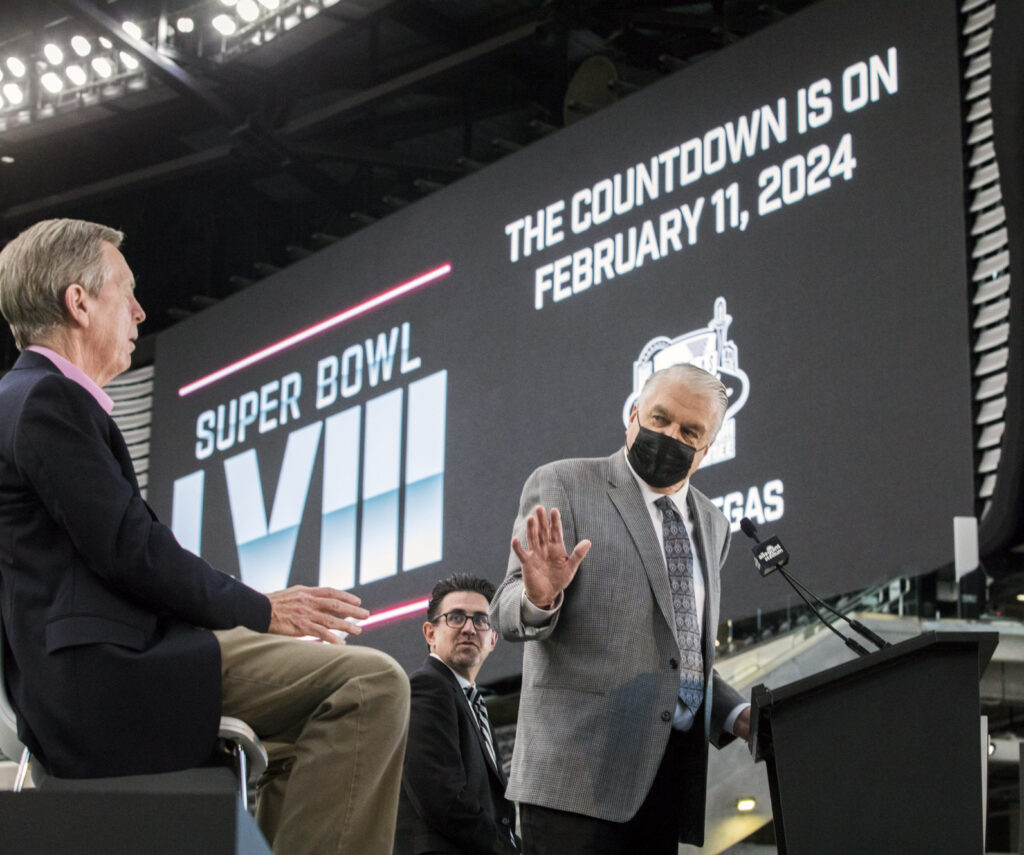
Even so, amid marked personal income growth fueled in part by stimulus and public benefits, the Las Vegas Strip’s largest corporations have seen a revenue boom as the worst of COVID’s public health effects have ebbed. In 2021, Nevada casinos recorded record revenues totaling $13.4 billion — a mark that the state has surpassed in just the first 11 months of 2022.
Separately, Sisolak has embraced his image as a business-friendly “sports governor,” an image buoyed as a stadium project he backed as a Clark County commissioner has helped attract premier sporting events — with a Super Bowl, NCAA Men's Basketball Final Four and more already calendared through the next half-decade.
Most recently, Sisolak has tied himself closely to the announcement of a Formula One Grand Prix in Las Vegas set for 2023, the first such race in the city since the 1980s and a first-of-its-kind deal struck directly between the state, the city and the management of Formula One.
Wielding the legislative trifecta
While it paved the way for progressive policy wins, the trifecta did not secure a Democratic caucus in lockstep with the party’s activists.
On the issue of the minimum wage, for instance — for a decade locked at just $7.25 per hour for employers offering health insurance — Democrats abandoned a 2017 bill raising the minimum wage to $15, backed by activists, for a diluted version that would raise it to $12 over the course of five years, instead.
Separately, Sisolak made good on one of his earliest tentpole promises — a push to secure collective bargaining rights for state workers, who were long locked out of unionization efforts by state law.
AFSCME Local 4041 President Harry Schiffman said that he was happy with the relationship the union had with Sisolak during his time in office, looking back on the work done for bargaining agreements for state employees and Sisolak’s efforts to reduce furloughs during the pandemic.
“He valued or saw a positive working with our union,” Schiffman said. “He was supportive of many issues that were important to us as state workers.”
But few unions flex political muscle like the Culinary Workers Union Local 226, the hospitality workers union in Las Vegas and long one of the state’s most powerful political forces. To that end, Sisolak was a key Culinary ally in 2021, backing a “Right to Return” bill allowing hospitality workers the right to return to jobs they lost during the pandemic.
The union later praised Sisolak for the move during the 2022 midterms, and in an interview last month, union Secretary-Treasurer Ted Pappageorge — who directly credited Sisolak for the Right to Return bill on the campaign trail — called Sisolak’s exit “a tremendous loss.”
“He was a true champion of the working class families in Nevada, we believe, and that's a big loss,” Pappageorge said.
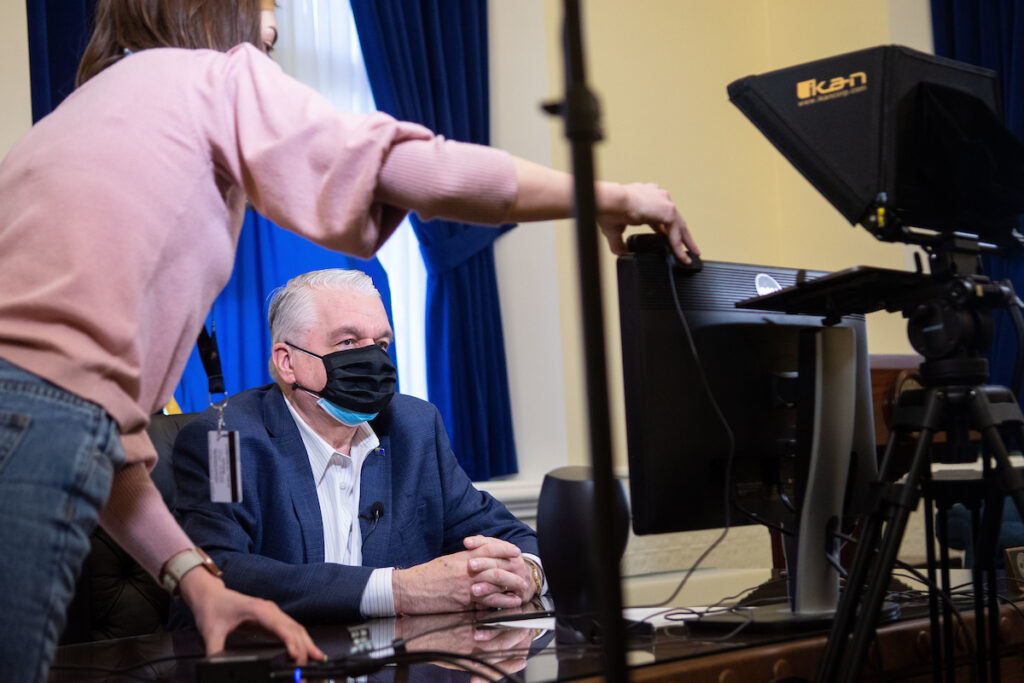
And on the issue of criminal justice reform, Sisolak signed a host of Democrat-backed reforms in 2019, a 2020 special session and 2021 — though several key policy goals for Democratic activists were also quashed under Sisolak’s term.
Just as the Democrat-led Legislature and Sisolak signed bills that decriminalized traffic tickets, banned arrest quotas, narrowed justifications for the use of force by police and expanded the attorney general’s ability to conduct pattern and practice investigations, measures that would have ended cash bail floundered in 2019 (though a separate state Supreme Court ruling did later lead to significant changes to the cash bail system). And a bill abolishing the death penalty died before making it to the governor’s desk in 2021.
Sisolak also presided over a change to the state’s electoral system that has not only created a new election paradigm for the 2020 presidential and 2022 midterm elections, but has promised to reshape the way campaigns are waged in cycles to come.
Passed initially as an emergency measure to prevent COVID transmission in 2020, and later codified permanently in 2021, the changes created universal mail-in voting that would send a mail ballot to every active voter on county rolls.
Combined with a separate, voter-led initiative to create a system of automatic voter registration at the state DMV — an initiative that has rapidly swelled voter rolls, including a large number of registered nonpartisan voters — the move to mostly mail has fundamentally reshaped Nevada elections.
In 2020, for instance, the state saw a “red mirage,” as Republican-leaning ballots cast and reported on Election Day were swallowed up by late-arriving, Democrat-leaning mail ballots counted in the days that followed — votes that ultimately proved critical to Joe Biden defeating Donald Trump.
Similarly, history repeated itself in 2022. Even as they lost ground in the traditional “blue wall” of Clark County, Democrats saw gains in late-counted mail ballots relative to ruby-red Republican Election Day turnout — enough to save Democratic Sen. Catherine Cortez Masto in the race for U.S. Senate, but not nearly enough to rescue Sisolak.
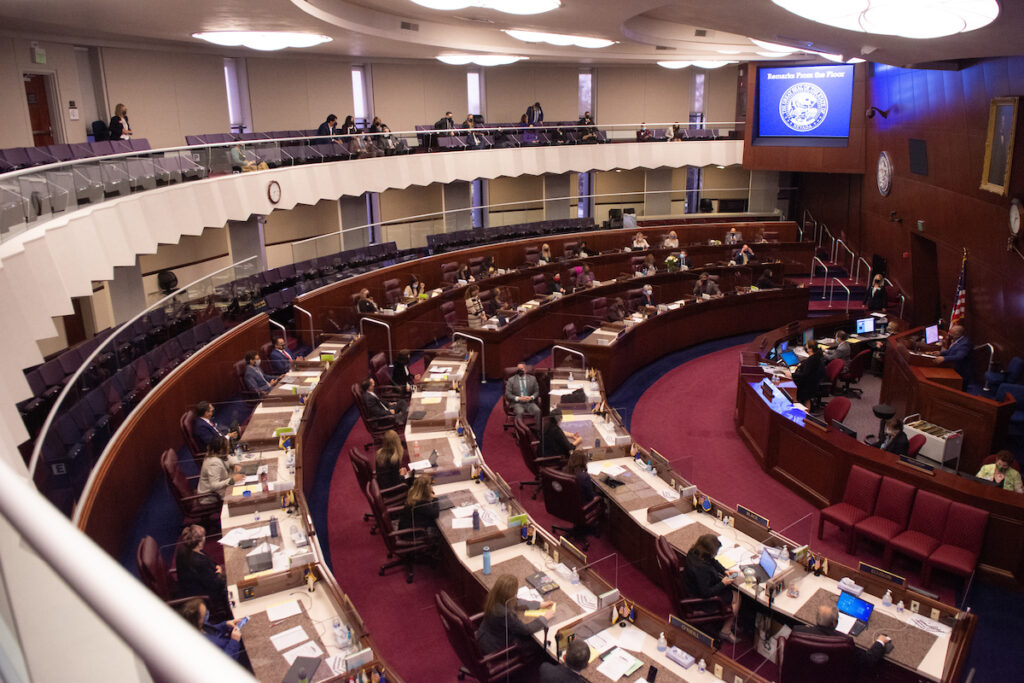
So too did Sisolak and the Democrats tackle climate issues, in large part by raising the state’s Renewable Portfolio Standard (RPS), a baseline requirement for statewide renewable energy development, to 50 percent by 2030. The move to gradually raise the state’s use of renewable energy came just two years after Sisolak’s Republican predecessor vetoed a measure to raise the RPS to 40 percent in the same time period.
“Sisolak was an environmental champion from the very beginning,” Nevada Conservation League’s Deputy Director Christi Cabrera-Georgeson told The Nevada Independent.
Cabrera-Georgeson praised the move to increase the RPS, as well as a state climate strategy published by the Sisolak administration in 2020 aimed at creating a roadmap to zero-out carbon emissions by 2050.
Still, Patrick Donnelly, the Great Basin director for the Center for Biological Diversity, described Sisolak’s environmental legacy as “complicated.”
“Instead of energy democratization — instead of focusing on rooftop and community solar and solutions that will empower people — we've seen solutions that will enrich Warren Buffett and his shareholders at NV Energy,” Donnelly said.
He also said Sisolak favored extractive industries when it came to managing public lands.
“[Sisolak’s staff] were engaged with the conservation community. They were willing to listen. I think they tended to prioritize extractive industry over conservation,” Donnelly said. “Whether it's mining, whether it's even oil and gas production that they failed to stop or rein in.”
Even as Democrats lost vote share in 2020 relative to the 2018 wave, they still maintained their control of a legislative trifecta. More than that, better-than-expected revenue projections and a sudden windfall of more than $2.7 billion in federal COVID aid through the American Rescue Plan mitigated large chunks of planned budget cuts.
Much of that money has allowed Sisolak additional latitude to accomplish goals from the 2018 campaign, in part by getting certain spending programs approved by the legislative Interim Finance Committee outside of regular legislative sessions. That includes massive spending programs for infrastructure, including $250 million for affordable housing projects and another $204 million for expanding broadband internet access.
Sisolak also signed a bill in 2021 making Nevada only the second state nationwide to adopt a public health insurance option, a measure that will set price ceilings for premiums listed under “public option” plans certain insurers will be required to offer.
However, specifics of that public option remain in flux as the process continues through study and planning phases, and it won’t be available for purchase until 2026.
Still, other moves by Sisolak to brand Nevada as a trailblazing policy state floundered.
His relationships with business drew scrutiny amid the rapid rise and fall of the “Innovation Zones” concept. A proposal backed by the cryptocurrency company Blockchains — owned by Jeffrey Berns, a major Sisolak campaign donor — would have created autonomous “zones” effectively allowing Blockchains to operate a city within Storey County with its own separate municipal government. Sisolak touted the idea in his 2021 State of the State address, and later backed the initial proposal when draft legislation emerged during the session.
But amid increasing public skepticism and a lack of legislative support, the plan — and Sisolak’s support of it — was scrapped by April, and abandoned by Blockchains later that year.
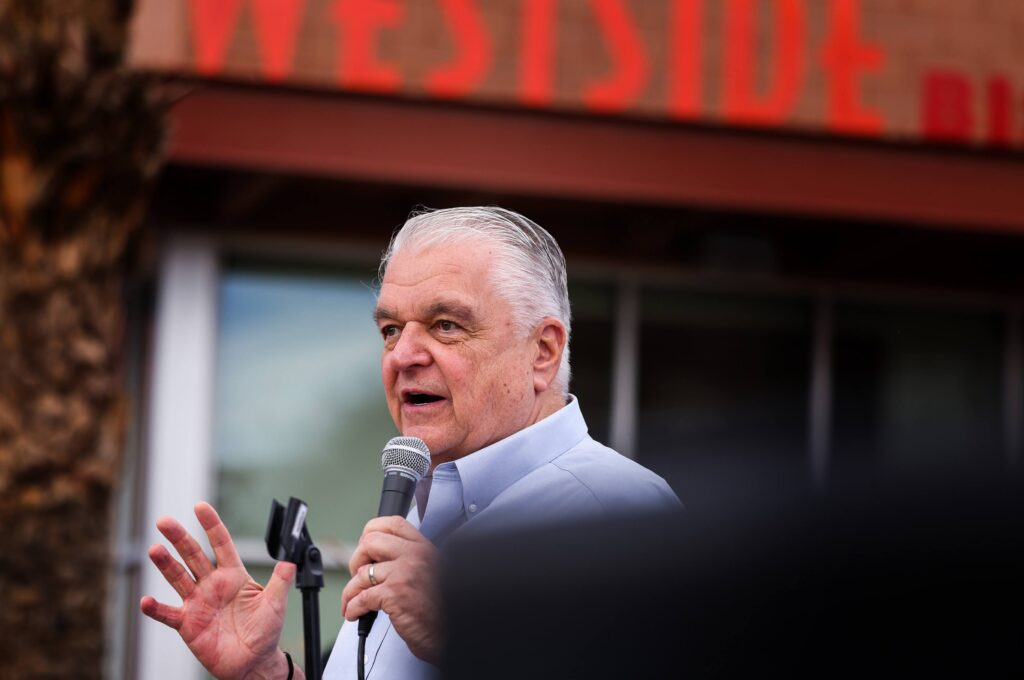
One last election
In the 2022 election, the issues that came to dominate the national discourse came to dominate Nevada’s campaigns, too. The economy and abortion rights set against each other in dueling campaign advertisements flooding the airwaves day and night. Crime and COVID ate up whatever space was left.
Sisolak sought to rely on his record, touting the state’s economic recovery following the pandemic in a bid to mitigate the electoral pressure of rising housing costs and punishing surges in food and gas prices.
He also promised no new taxes. In one campaign ad, he even touted not raising taxes “on Nevada families” during his tenure — eliding the increase in the mining tax, the approval of county-level sales tax increases, and the preservation of a state payroll tax that the Sandoval administration had designed to sunset.
He also sought to downplay his opponent’s record as Clark County sheriff amid mixed crime statistics, attack Lombardo’s policy plans on education privatization and corner him on hot-button issues, such as abortion.
But economic headwinds remained. All the while, Sisolak faced institutional crises his administration had not solved, including a deepening staffing crisis at state agencies such as the Nevada Department of Corrections.
So too was Sisolak bogged by the finer decisions of his administration on COVID more broadly, including regarding Northshore Labs. A COVID testing company with links to a major campaign donor, Northshore was among the companies fast-tracked in the early days of the pandemic to provide COVID testing services in Nevada but was later found to have missed 96 percent of positive tests in a sample from UNR.
Sisolak defended his administration’s actions on Northshore on the campaign trail, arguing in a debate that the early pandemic required the fast-tracking process, and that the contract was axed when state officials were alerted to the issues. But the story opened an avenue for Lombardo and Republican outside groups, who hammered Sisolak for months over the story as they kept COVID — and the governor’s response to it — on the airwaves.
In the end, Sisolak’s defense wasn’t enough. He lost to Lombardo by a little more than a percentage point in the statewide vote, even as those same voters elevated fellow Democrat Cortez Masto to another term in the Senate. In a statement three days after Election Day, Sisolak said he conceded to Lombardo because he believed in the election system and honoring the will of voters.
During his final days in office, Sisolak’s office sent out a long laundry list of his accomplishments, and described the highlights of a budget his administration helped design but that another administration would be able to change. It included hopes for more education funding than he was ever able to provide, and state employee raises larger than he accomplished in office.
Sisolak’s staff has not said exactly what the governor plans to do after he leaves office this week. But in his concession statement, he described his time as the state’s chief executive as the apex.
“For this single dad and son of a blue collar factory worker, the opportunities this state has given me are more than I could have ever asked for,” he said. “It has been the honor of my life to be your governor.”



